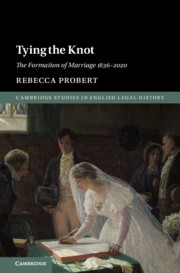Book contents
- Tying the Knot
- Cambridge Studies in English Legal History
- Tying the Knot
- Copyright page
- Dedication
- Contents
- Preface and Acknowledgements
- Abbreviations
- 1 Introduction
- 2 Conception, Design, and Implementation, 1819–1837
- 3 Reactions to the Act, 1837–1854
- 4 Amendments Enacted and Reform Deferred, 1855–1872
- 5 Differences, Divisions, and Dispensing with the Registrar, 1873–1899
- 6 Competing Conceptions of Marriage, 1900–1919
- 7 Consolidating Complexity, 1920–1949
- 8 Convergence? 1950–1993
- 9 The Rise of the Wedding, 1994–2020
- 10 The Legacy of the Past and Lessons for the Future
- Index
5 - Differences, Divisions, and Dispensing with the Registrar, 1873–1899
Published online by Cambridge University Press: 10 September 2021
- Tying the Knot
- Cambridge Studies in English Legal History
- Tying the Knot
- Copyright page
- Dedication
- Contents
- Preface and Acknowledgements
- Abbreviations
- 1 Introduction
- 2 Conception, Design, and Implementation, 1819–1837
- 3 Reactions to the Act, 1837–1854
- 4 Amendments Enacted and Reform Deferred, 1855–1872
- 5 Differences, Divisions, and Dispensing with the Registrar, 1873–1899
- 6 Competing Conceptions of Marriage, 1900–1919
- 7 Consolidating Complexity, 1920–1949
- 8 Convergence? 1950–1993
- 9 The Rise of the Wedding, 1994–2020
- 10 The Legacy of the Past and Lessons for the Future
- Index
Summary
With the emergence of new and more informally organised Nonconformist groups, evidence of noncompliance within the Greek Orthodox community and among Jewish immigrants, and the first recorded Muslim marriage ceremonies, the prospect of radical reform faded. It was clear that delegating control over weddings to religious groups would result in considerable uncertainty about marital status. Divisions between Catholics and Nonconformists, and among different Nonconformists, meant that even the more limited issue of dispensing with the registrar could not be resolved simply by conferring authority on priests and ministers. The solution adopted in the Marriage Act 1898 was to allow ‘authorised persons’ to register marriages. While this seemed to accommodate the interests of different religious groups, the removal from the bill of any reference to authorised persons ‘solemnizing’ marriages, the regulations governing their appointment and actions, and the form of the new registers dispatched to them all served to undermine their status and make the role less attractive. The 1898 Act also added a yet further layer of complexity to the law governing weddings, with new distinctions between Catholics and Protestants, and between Christian and non-Christian groups.
Keywords
- Type
- Chapter
- Information
- Tying the KnotThe Formation of Marriage 1836–2020, pp. 115 - 146Publisher: Cambridge University PressPrint publication year: 2021



